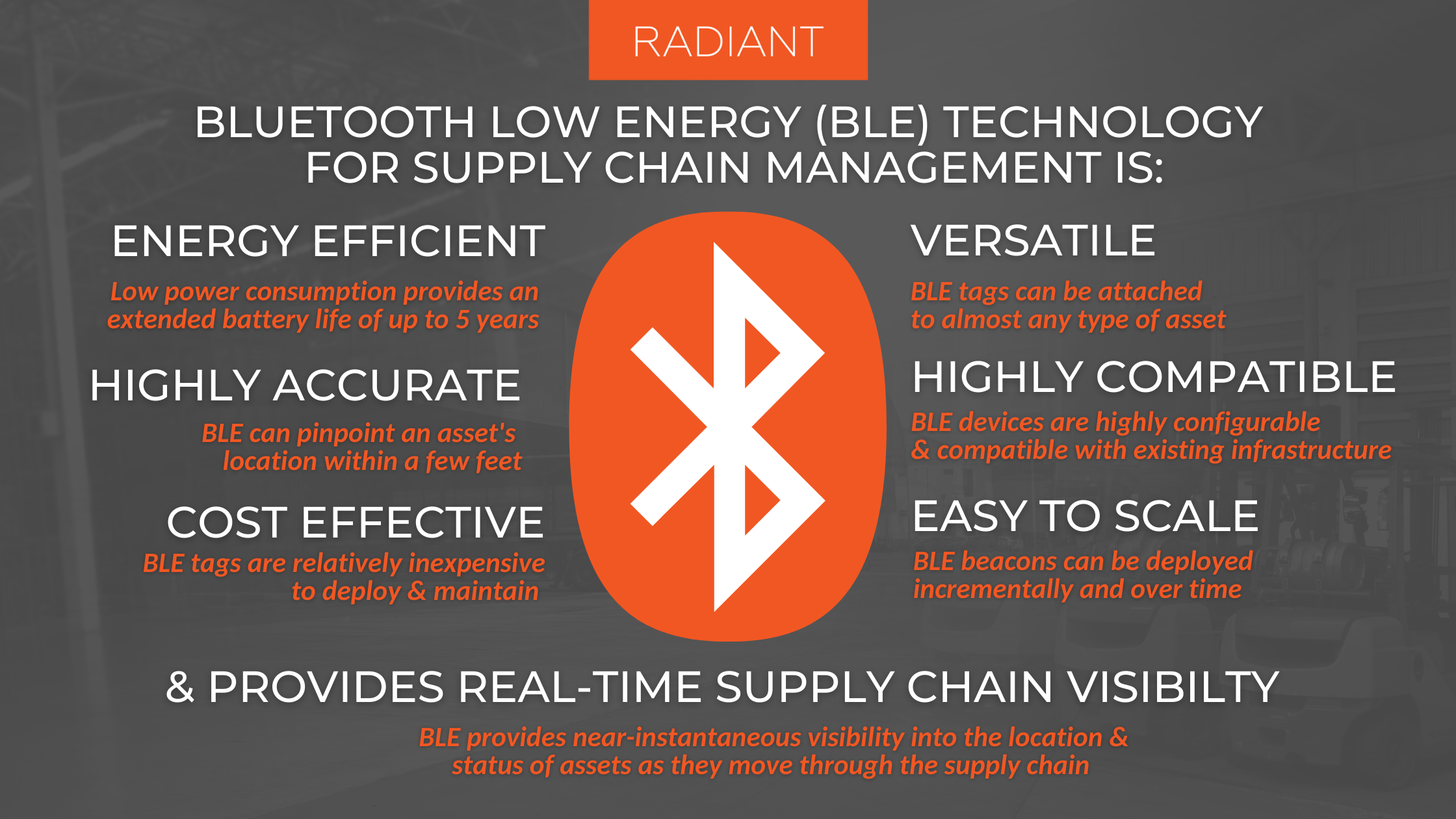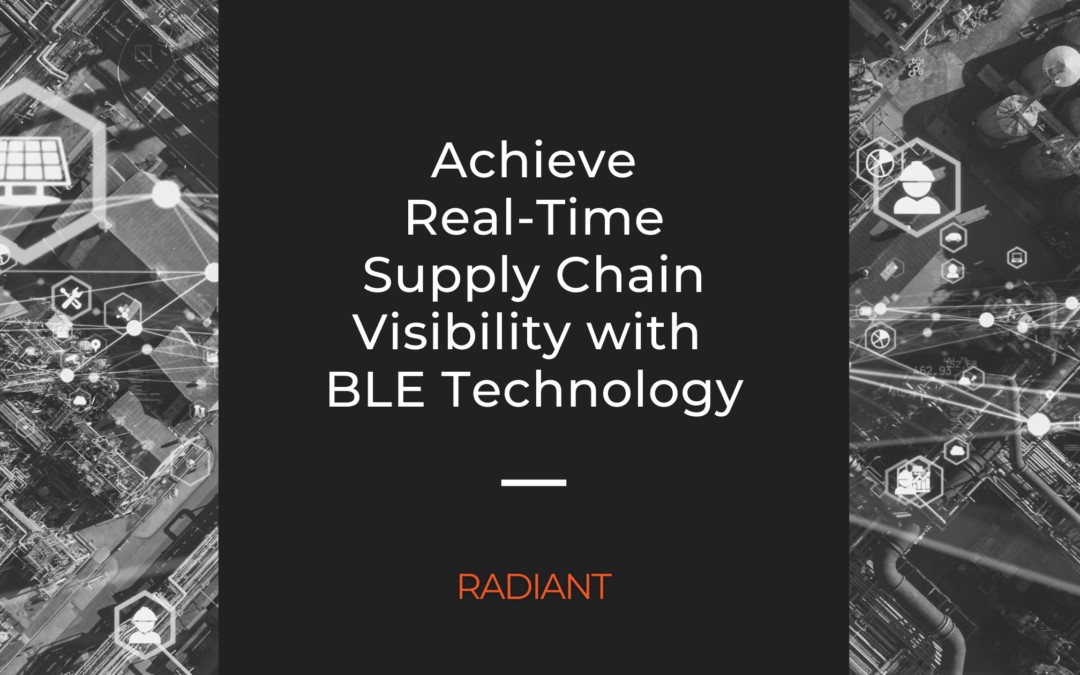In business, it is often said that “time is money.” This could not be more true than in the field of supply chain management, where even small delays can have a ripple effect on the entire operation. In order to keep your business running as efficiently as possible, you need to have complete visibility into your supply chain at all times.
Fortunately, Bluetooth Low Energy (BLE) technology can help you achieve this goal. By using BLE sensors and devices, you can track the location and movements of shipments and inventory in near real-time. This allows you to quickly identify any potential bottlenecks or disruptions in the supply chain and take corrective action.
If you’re looking for a way to improve supply chain visibility, then BLE technology is definitely worth considering. In this article, we’ll take a closer look at how BLE technology can be used for achieving real time supply chain visibility and more.
What is Bluetooth Low Energy (BLE) Technology and How Does it Work?
Bluetooth Low Energy (BLE) technology is a power-saving version of classic Bluetooth technology, a wireless personal area network technology that helps devices communicate with each other. BLE technology is based on Bluetooth 4.0, which uses a 2.4 GHz radiofrequency to communicate with devices at a short range.
BLE has a lower data rate than classic Bluetooth, which means that it can’t send the same amount of data per second. However, this lower data rate is offset by the fact that BLE devices can be put into sleep mode when they’re not being used, which significantly extends their battery life. As a result, BLE is an ideal choice for devices that need to be small and lightweight while still maintaining a long battery life.
For this reason, BLE devices are often used for tracking assets, as they can be easily integrated into existing systems and infrastructure, allowing businesses to keep track of their inventory with real time visibility. BLE sensors can have a read range of up to 100 meters, which makes them well suited for tracking assets in both indoor and outdoor environments.
BLE works by transmitting short bursts of data transfer at regular intervals. This low power consumption makes BLE ideal for battery-powered devices. BLE asset tags use these regular transmissions to communicate their location to a BLE gateway or BLE-enabled device. The gateway then forwards the asset information to a backend system where it can be processed and analyzed. This system can be as simple as a spreadsheet or as complex as a cloud-based inventory management system.
Bluetooth LE technology is helping businesses keep track of their assets more efficiently and with less cost than ever before. An essential part of the “Internet of Things,” BLE technology is expected to play a major role in the future development of connected devices.
How can BLE Technology be used to Improve Supply Chain Visibility for Businesses?
The term “supply chain visibility” is often used to describe the ability of businesses to track their assets and inventory as it moves through the supply chain. This information can be extremely valuable, as it can help businesses to identify bottlenecks, optimize production schedules, and even predict demand. However, achieving comprehensive supply chain visibility can be a challenge, especially for businesses that rely on traditional methods of tracking such as barcodes and RFID tags.
BLE technology offers a promising solution to this problem. By equipping assets such as products, parts, and returnable containers with BLE tags, businesses can use Bluetooth-enabled devices to track the location of their assets in real-time. This information can then be transmitted to a central database, which can be accessed by authorized personnel from any location. This gives businesses a much clearer picture of where their assets are at any given moment and helps to prevent lost or stolen items.
In addition to providing near-instantaneous visibility into the location and status of assets, BLE technology can also help businesses to reduce labor costs associated with manual tracking methods. As more and more businesses look for ways to improve their real time supply chain visibility, BLE technology is likely to play an increasingly important role.
Other Applications of BLE Technology in Supply Chain Management
BLE technology is not just limited to increasing real time supply chain visibility. There are a number of other potential applications for this type of IoT technology.
For example, BLE tags can be used to track the movement of inventory within a facility. This information can be used to improve the efficiency of operations by identifying potential bottlenecks and proactively reducing congestion.
In addition, BLE tags can be used to monitor the condition of goods in transit. This information can be used to ensure that products are not damaged during shipping and that they arrive at their destination in a timely manner.
As these examples illustrate, BLE technology has the potential to revolutionize the supply chain in more ways than one.
Advantages of Using BLE Technology in Supply Chain Management
Besides high visibility, BLE technology offers a number of advantages over other technologies, making it an ideal choice for companies looking to improve their supply chain management:
- Improved Accuracy: BLE devices have much higher positioning accuracy than traditional GPS devices. This is due to the fact that BLE signals can be received by multiple satellites simultaneously, which allows for more precise triangulation.
- Regular Transmissions: BLE tags transmit short bursts of data at regular intervals. This helps to ensure that real time data is transmitted in a timely manner.
- Cost Effective: BLE tags are relatively low cost, which makes them an affordable option for tracking large numbers of products or assets.
- Energy Efficiency: BLE tags do not require an external power source, which makes them easy to deploy and maintain.
- Versatility: BLE tags are much smaller and more versatile than other types of tags, making them well suited for use in a wide range of environments.
- Device Compatibility: BLE technology is compatible with a wide range of Bluetooth smart devices and infrastructure, making it easy to integrate into existing systems. This compatibility gives supply chain managers the flexibility to choose the tracking solution that best fits their needs.
- Scalability: BLE is highly scalable, meaning that it can be used in everything from small networks to large-scale deployments
BLE tags are already being used in a variety of industries, and their use is expected to continue to grow in the coming years. As BLE technology becomes more widely adopted, it has the potential to revolutionize how businesses operate by providing real-time supply chain visibility into the movement of inventory and assets.

Tips for Implementing BLE Technology in your own Supply Chain Operations
By this point, it is clear that BLE technology is a powerful tool that can be used to streamline supply chain operations. BLE beacons can be used to track inventory, assets, and returnable transportation items (RTIs) throughout the supply chain. By implementing BLE technology, companies can increase efficiency and decrease costs. Here are a few tips for implementing BLE technology in your own supply chain:
- Define your Goals: Before you can implement BLE technology, you need to decide what you want to achieve with it. Do you want to use it to track returnable containers? Tracking inventory levels? Improve asset utilization? Optimize route planning? Once you have defined your goals, you can develop a plan for how to achieve them.
- Assess your Current Infrastructure: BLE technology will only be as successful as the infrastructure supporting it. Do you have a robust Wi-Fi network in place? Are your BLE-enabled devices compatible with your existing systems? By taking a close look at your infrastructure, you can identify any potential bottlenecks before they cause problems further down the line.
- Select the Right BLE Solution & Vendor: Not all BLE solutions are created equal. You need to choose a solution that is compatible with your existing infrastructure and that offers the features you need to meet your goals. It’s also important to select an IoT vendor that not only has experience deploying BLE solutions in your industry, but that has proven record of success in supply chains similar to yours.
- Develop a Deployment Plan: BLE beacons need to be carefully deployed in order to be effective. You need to consider factors like beacon placement, power requirements, and data security when developing your deployment plan. This is another reason why selecting the right BLE solutions provider for your business is crucial.
- Test and Evaluate: Once you have deployed your BLE beacon, it is important to test it and make sure it is working as intended. You should also periodically evaluate your system to ensure that it is still meeting your goals.
BLE technology can be a powerful asset to any supply chain. By following these tips, you can successfully implement BLE technology in your own operation.
Achieve Real Time Supply Chain Visibility with Radiant’s BLE Solution
At Radiant, we are always looking for ways to empower our customers to make better informed decisions about their most critical assets and real time supply chain visibility does just that. We believe that Bluetooth Low Energy (BLE) technology is the future of supply chain management and we have developed a solution that uses this technology to provide supply chain leaders with advanced analytics and valuable insights through our IoT platform.
If you’re ready to achieve real time supply chain visibility, please do not hesitate to explore our solution further and request your demo below. Thank you for reading.
Last Updated on September 13, 2022 by Radiant

